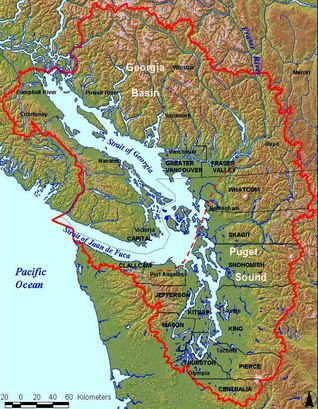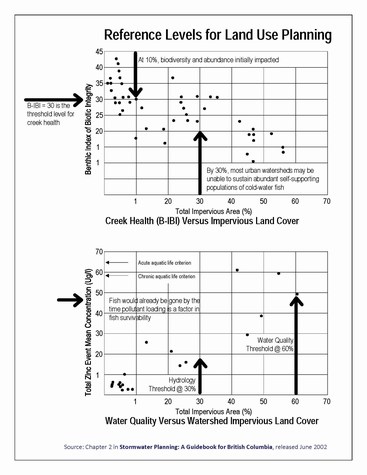Will Proposed Low Impact Development Standard Protect or Harm Washington State Watersheds?

Rainwater Management in Puget Sound
In August 2008, the Washington State Pollution Control Hearings Board issued a ruling declaring effectively that the Department of Ecology’s (ECY) storm drainage requirements did not adhere to requirements of the federal Clean Water Act. In response, ECY formed a technical advisory committee to define ‘low impact development’ (LID) and to determine criteria for feasibility of LID. The committee finished its work in summer 2010.
Request for Intervention by Governor Gregoire
In a recent letter to Governor Christine Gregoire, the Carnegie Group of Olympia has expressed its concerns about the pending regulatory direction. “As a result of this overly long process, ECY now proposes to write a perplexing version of ‘low impact development’ into National Pollution Discharge Elimination (NPDES) permits for municipalities,” wrote Carole Richmond, President.
 The letter asks the Governor to intervene to prevent the adoption of a proposed rule that the Carnegie Group believes “will most likely spell the demise of Puget Sound by failing to protect tributary watersheds”.
The letter asks the Governor to intervene to prevent the adoption of a proposed rule that the Carnegie Group believes “will most likely spell the demise of Puget Sound by failing to protect tributary watersheds”.
The letter states that the proposed standard offers no improvement over the existing standard. To provide context and a frame of reference, the letter then summarizes the science of watershed health.
“It is clear that ECY’s proposed standard for low impact development is far too weak and permissive to prevent fatal damage to Puget Sound watersheds….it is highly likely that we will lose the rest of the watersheds in the path of development by 2020,” concluded Carole Richmond.
The Carnegie Group makes four recommendations, summarized as follows: acknowledge the characteristics of a healthy watershed; redefine LID; place a moratorium on greenfield developments outside city limits; and require that re-development projects result in a net increase in forest cover.
To download a copy of the letter, click on Department of Ecology’s Proposed Low Impact Development Standard Will Not Protect Watersheds
VIDEO: “Why DOE drainage standards will not protect Puget Sound”, according to Tom Holz
Tom Holz is well-known in Washington State for his tireless efforts in leading change in the field of rainwater management and green infrastructure. Among Canadian  practitioners in this field, Tom Holz is a recognized name in the provinces of British Columbia and Alberta, as he has been invited to speak at a number of Canadian forums over the past two decades. Formerly with the City of Olympia, he is a Past-President of the Carnegie Group. He also served on the LID technical advisory committee.
practitioners in this field, Tom Holz is a recognized name in the provinces of British Columbia and Alberta, as he has been invited to speak at a number of Canadian forums over the past two decades. Formerly with the City of Olympia, he is a Past-President of the Carnegie Group. He also served on the LID technical advisory committee.
In the late 1990s, Tom Holz coined the acronym ZID – that is, Zero Impact Designs – to describe an approach that sharply reduce the “effective impervious area” of new development with practices such as eco-roofs, roof gardens, rain barrels, alternative paving surfaces, soil amendments, bioretention, reforestation, and filter-swale systems.
To Learn More:
In March 2011, the Thurston County Board of County Commissioners requested a seminar by Tom Holz on “Why DOE drainage standards will not protect Puget Sound”. The seminar is posted on YouTube. To view Tom Holz, click on the two links below:
- http://www.youtube.com/watch?v=rxlezjpGXSU(52 minutes
- http://www.youtube.com/watch?v=4n5nFD6x7ps (14 minutes0
The first link is about 52 minutes (fast forward to the 4.13 minute mark to get past the set up). The second link is closing and discussion with decision makers and public. “It’s a bit dry so make a bowl of popcorn,” recommends Tom Holz.
To download a copy of the letter of concurrence submitted by Tom Holz, click on Letter to Governor Gregoire about the Future of Puget Sound
The View from British Columbia
Washington State and British Columbia are geographically similar, with a wet coast and a relatively dry interior separated by mountain ranges. On the coast, Washington State’s Puget Sound and British Columbia’s Georgia Basin together comprise the Salish Sea. In terms of how rainwater management in a watershed context has evolved in this shared bio-region, there is a history of cross-border sharing and collaboration. The catalyst for collaboration was the salmon crisis of the 1990s.
What is the Goal?
“On both sides of the border, the salmon is an icon. It is also the early warning system that there is a problem. And so in the 1990s the goal of p rotecting stream health became a driver for action on both sides of the border. Published in 1996 by the University of Washington, the seminal research findings by Richard Horner and Chris May shook conventional stormwater management wisdom in the Pacific Northwest to its foundation,” recalls Kim Stephens, Executive Director of the Partnership for Water Sustainability in British Columbia.
rotecting stream health became a driver for action on both sides of the border. Published in 1996 by the University of Washington, the seminal research findings by Richard Horner and Chris May shook conventional stormwater management wisdom in the Pacific Northwest to its foundation,” recalls Kim Stephens, Executive Director of the Partnership for Water Sustainability in British Columbia.
“Horner and May identified and ranked the four factors that limit stream health. Changes in hydrology is #1; deterioration in water quality is #4. The work of Horner and May is a foundation block for the science-based approach to ‘designing with nature’ that we have embraced in BC. Their work yielded guiding principles, and these are standing the test of time. Viewed from a BC perspective, the legacy of Horner and May is that they provided us with a springboard to reinvent urban hydrology. By staying true to the science, we believe we will achieve the goal of protecting stream health.”
To Learn More:
British Columbia and Washington State had the same understanding of the science in the late 1990s, but then moved along different pathways. To access supporting information on the approach that has been implemented in British Columbia, click on:
- DFO Urban Stormwater Guidelines have evolved into ‘Beyond the Guidebook 2010’
- A Science-Based Road Map for Integrated Rainwater Management
(Note: This article elaborates on the Reference Levels for Land Use Planning graphic that is presented below. To download a PDF copy of it, cilck here) - “Understand How Water Reaches the Stream and Design for Interflow”, urges Department of Fisheries and Oceans
Also, for a philosophical perspective, click on Do you know where you really are in the shifting paradigms of stormwater management?
And finally, for a technical perspective on why it was necessary to “reinvent urban hydrology”, click on Voodoo Hydrology explained by Andy Reese.
Related Stories About Puget Sound on Water Bucket
Posted August 2011


